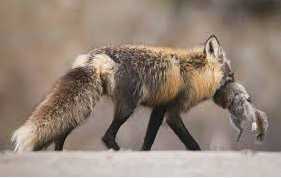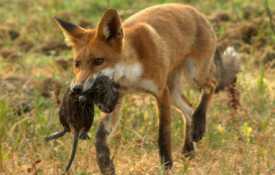The red fox or simply fox (Vulpes vulpes) is the largest of the foxes.

Red Fox
These animals can measure between 75 and 140 cm and their weight can vary between 3 and 11 kg: these measurements mean that red fox the largest of its kind.
The color of the fox is normally reddish but can also be found varying from yellow to brown, depending on the individuals and regions.
The throat, belly, and extremity of the tail are white; the latter is long and thick.
The snout is elongated and the ears are triangular and extremely mobile.
Among the foxes of the genus Vulpes, the red fox is more linked to carnivorism.
In addition to its larger dimensions, it is further distinguished from the other foxes by its ability to adapt to any environment. Despite its name, the species is not always red, as both the albino and melanic specimens have been reported.
Contents
Where did the Red Fox originate from?
Today, 45 subspecies are recognized, which are further divided into two categories: the large northern red foxes and the small southern red foxes of the Asian and Middle Eastern deserts.
The species originated from the smaller ancestors of Eurasia during the middle Villafranchian and came into North America shortly after the Wisconsin glaciation.
According to reports, they could have descended either from Vulpes alopecoides or the Chinese V. chikushanensis, both of which lived during the middle Villafranchian.
It is probable that the ancestral species was smaller than today’s form, as the oldest fossil findings of red fox are invariably smaller than their descendants.
The species was restricted to the far north of North America and began to expand south only after a period of climatic change due to human activities.
There are two types of red foxes in North America, separated since the Wisconsinian.
The borug refugium appeared in Alaska and western Canada, and consists of the large subspecies Vulpes vulpes alascensis, Vulpes vulpes abietorum, Vulpes vulpes regalis, and Vulpes vulpes rubricosa.
The mountain refugium, however, appeared in the protected subalpine zones and the alpine fields of the rocky mountains.
Characteristics and habits of the Fox
How Do they Hunt and What Do They Eat?
Despite being classified as a carnivore, the fox is an omnivorous animal and a great opportunist. It is able to hunt prey of different sizes, from insects of 0,5 cm of length to birds of 1,5 m wingspan.
The fox mainly feeds on small rodents but also hunts;
- rabbits
- terrestrial birds (ground bird)
- reptiles
- invertebrates (no backbone)
- and young ungulates. (larger mammals)
What hunts a fox?
Although it tends to kill smaller predators, including other fox species, it is vulnerable to attacks by larger predators such as;
- wolves
- coyotes
- jackals
- and various large felines (such as leopards)
- or medium size (such as lynx)
What does a fox eat?
The diet of a fox is based on a wide variety of species: invertebrates, small mammals, birds, eggs, small amphibians, and reptiles.

Fox with Prey
Its particularly welcome plants include berries and other types of fruit.
They can also feed on carrion and anything edible they encounter.
Foxes usually hunt on their own.
With their refined sense of hearing they can spot small mammals in the tall, thick grass and spring into the air and pounce on their unsuspecting victim.
They can also hunt prey such as rabbits by lurking stealthily and silently approach them.
Foxes tend to have a very obsessive attitude towards food and rarely share it with other specimens: the behavior of the mating and mating period with their puppies is an exception.
How much food do foxes eat?
The amount of food consumed daily varies from 0.5 kg to 1 kg.
Red foxes have a small stomach compared to their size and for this reason, they can only eat half of what dogs or wolves can ingest compared to their size.
In times of abundance, foxes set aside food supplies for the future, burying them in small holes of 5 to 10 cm. They tend to hide food in many small hiding places rather than in a single ‘department store’.
It is thought that they act in this way so as not to risk losing the entire stock at once.
Behavior patterns of the fox
Normally the fox will live in pairs, with puppies and couples, although sometimes it is possible to observe solitary specimens or in groups of 4 or 6 adults.
The male marks the territory systematically and communicates with his peers through sound, visual, tactile and olfactory signals. A fox can recognize another specimen from the scent and odor, as well as deciphering its hierarchical rank and social level.
It is significant to point out that, in this species, the couple tends to mate each year and that the male usually actively participates in the care and breeding of offspring, procuring food and defending the puppies from possible predators.
To live in a wide variety of different environments, foxes must have a great ability to adapt. In fact, the phenomenon of two distinct populations of foxes that behave as if they were totally different species should not seem strange.
Their territory can extend for 50 km and can be drastically reduced even to 12 km in areas where food is abundant.
How do foxes mark their territory?
They mark their territory by means of odoriferous glands placed near the tail. The odorous substance secreted by this gland is composed of thiols and thioacetate, very similar, even if possessed in smaller quantities, to those by skunks.
How do foxes communicate?
Family members communicate with each other through body language and the emission of different sounds. They have a wide range of vocalizations used according to the most specific situations.
They can also communicate with each other through smell and therefore often mark their food and the land with urine.
They often use burrows used by animals such as badgers or rabbits. Badgers are among the main enemies of foxes and often threaten to devour puppies.
At what time of the day can you see a fox?
Foxes are crepuscular or even nocturnal animals in areas where human intervention is massive (and there is artificial light); for these reasons, they are more active at night than during the day.
Generally, they are solitary hunters. Foxes are territorial animals and defend their territory in pairs during the winter and alone during the summer.
Foxes and reproduction
The mating season varies according to latitude. In parts of Europe, their mating period often takes place in winter, between December and February. In other regions, it generally takes place between March and April.
The female, after a gestation of 7 weeks, gives birth, in a den, to an average of 3 to 5 pups, which are breastfed for a month.
At the end of this period, they start taking the first solid foods, consisting of foods pre-digested by the mother and then regurgitated.
This technique is very advantageous as it allows to feed the litter without bringing the carcasses close to the den and possibly attract predators whilst at the same time it makes the little ones not have to move in search of food, exposing themselves to possible dangers.
During the first two weeks of life, the mother does not abandon the puppies and devotes herself entirely to their breastfeeding while she is fed by the male.
The female does not hesitate to transport her young ones to safer places if there are threats near to the burrow. The young ones come out of the den for the first time around the fourth or fifth week and are very playful.
What is the lifespan of the fox?
In nature, this species can reach an age of 12 years.
Where is the Fox found and how dangerous Is It?
The fox is primarily a carnivore therefore it can be a threat to most other mammals smaller than itself whilt it can be found throughout the northern hemisphere from the Arctic circle to North Africa, North America, and Eurasia.
Its range has expanded along with the human range, having been also found in Australia, where it is considered harmful to marsupials and native birds.
Because of its ecological damage in the latter continent, the species is considered one of the worst invasive species.
However, it is classified as a minimal risk species by the International Union for Conservation of Nature (IUCN).
The Fox and Relationship with Man
The species has a long history of association with humans, having been actively hunted as a pest or for its fur for many centuries.
Often times, it is the protagonist of many fairy tales and legends. In fact, there are stories that portray the intelligence of this animal. Given its vast range and large population, it is among the most important animals in the fur trade.
Foxes have always had an ambivalent impact in the imagination of man: on the one hand, they are considered a problem, as they prey on small poultry, on the other hand, they have always been admired for their beauty and cunningness.
They are very useful especially in agriculture because of their ability to free the fields from various species of rodents, which damage crops.
Fox and Human Captivity
The ideal place for every living being is its natural habitat, where it is capable of reproducing, feeding and relaxing in the most complete freedom, coexisting with other organisms.
This has not always been possible though.
Many times, animals have had to remain in an environment controlled by humans for a time or throughout their lives.
Life at the zoo
Many zoos in the world harbor certain species of foxes, which has been done with different objectives: to entertain an audience, for the study and protection of the species, to cure an ill or injured individual and then reintroduce it to their natural habitat, etc.
The truth is that it is not so strange to find foxes behind bars.
The arctic fox (Vulpes lagopus) is one of the most popular species in zoos. Its white fur is one of its biggest attractions and that attracts hundreds of people to admire it.
Of course, its enclosure must be conditioned with everything it needs and be as close as possible to its natural habitat, and this includes the climate.
The same happens with the fox fnec (Vulpes zerda), which requires a warm environment which it is specifically adapted to.
The big zoos of the world tend to have education and conservation programs aimed at the general public, so that people can meet animals that they would not otherwise be able to, and learn the most important facts about their lives.
Some zoos have little known species, such as the long-eared fox or otocyon (Otocyon megalotis), whose ears have an obvious resemblance to those of bats.
Darwin’s fox in captivity
The Darwin’s fox or fox chilote (Lycalopex fulvipes) is another species not very well known outside its distribution zone, the south of Chile.
It is in critical danger of extinction, and the number of mature individuals in the wild is so low that it is suggested that it could disappear in the coming years if no early decisions are made. In this regard, it has been suggested that it is a suitable species for captive breeding, that is, for a number of individuals to be placed inside an enclosure with the objective of reproducing them.
Can the Fox Be Domesticated?
If the dog is man’s best friend, can the fox become one?
After all, both are canids. This is what Soviet scientist Dmitri Konstantinovich Belyaev seemed to think, famous for launching an experiment of domestication of silver foxes, a variant of the red fox (Vulpes vulpes) whose coat exhibits a dark tonality with slightly silvery or gray back, with the tip of the tail of white color.
It is true that breeding in captivity may represent the lifeline for some animals that are seriously threatened, but it is also true that humans have had some responsibility in the situation.
For example
Darwin’s fox has been illegally kept as a pet on Chiloé Island, despite the fact that it is an endangered animal and that foxes are wild animals.
An example of the case of domestication of these wild animals is with the Belyaev Program which began in 1959. Interested in the process of domestication, he and his colleagues selected several silver foxes, which by the way many of them are raised on fur farms to take advantage of their beautiful fur, and kept them locked with minimal contact with human beings to avoid environmental influences.
As time progressed, they discarded the most “wild” foxes and left the meek ones in captivity to reproduce.
After a few years, the foxes began to show a different behavior, very similar to that of domestic dogs (Canis lupus familiaris).
The experiment continues today, and domesticated individuals are known as “Siberian foxes”, which prove to be much more social than their wild congeners and interact with human beings in a pleasant and calm way, without fear.
They also exhibit physical changes, such as the presence of specks on the coat.
The reasons why foxes are kept in captivity are varied, but we must not overlook the fact that they are eminently wild animals and need to live according to their nature.
